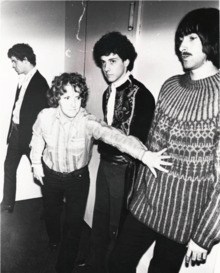Noise rock
Noise rock (sometimes called noise punk)[2] is a noise-oriented style of experimental rock[3] that spun off from punk rock in the 1980s.[4][5] Drawing on movements such as minimalism, industrial music, and New York hardcore,[6] artists indulge in extreme levels of distortion through the use of electric guitars and, less frequently, electronic instrumentation, either to provide percussive sounds or to contribute to the overall arrangement.[4]
| Noise rock | |
|---|---|
| Other names | Noise punk |
| Stylistic origins | |
| Cultural origins | c. 1967–1980s, New York City, United States |
| Typical instruments |
|
| Derivative forms | |
| Fusion genres | |
| Other topics | |
Some groups are tied to song structures, such as Sonic Youth. Although they are not representative of the entire genre, they helped popularize noise rock among alternative rock audiences by incorporating melodies into their droning textures of sound, which set a template that numerous other groups followed.[4]
Characteristics
Noise rock fuses rock to noise, usually with recognizable "rock" instrumentation, but with greater use of distortion and electronic effects, varying degrees of atonality, improvisation, and white noise. One notable band of this genre is Sonic Youth who took inspiration from the no wave composers Glenn Branca and Rhys Chatham.[7]
Sonic Youth's Thurston Moore has stated: "Noise has taken the place of punk rock. People who play noise have no real aspirations to being part of the mainstream culture. Punk has been co-opted, and this subterranean noise music and the avant-garde folk scene have replaced it."[8]
History

While the music had been around for some time, the term "noise rock" was coined in the 1980s to describe an offshoot of punk groups with an increasingly abrasive approach.[5] An archetypal album is the Velvet Underground's White Light/White Heat (1968).[9][5] Treblezine's Joe Gross credits the "cult classic" with being the first noise rock album, accordingly, "perhaps it’s an obvious starting point, but it’s also the starting point. Period."[5]
While noise rock has never had any mainstream popularity, the raw, distorted and feedback-intensive sound of some noise rock bands had an influence on grunge. Among them are Wisconsin's Killdozer, and most notably San Francisco's Flipper, a band known for its slowed-down and murky "noise punk". The Butthole Surfers' mix of punk, heavy metal and noise rock was a major influence, particularly on the early work of Soundgarden.[10]
Starting in the 1990s, noise punk developed mostly as a form of party music, with the band Lightning Bolt serving as key players in the 2000s noise punk scene in Providence, Rhode Island.[11]
References
- Gardner, Noel (March 30, 2016). "The Sound Of Impact: Noise Rock In 1986". The Quietus. Retrieved September 30, 2017.
- Felix 2010, p. 172.
- Osborn, Brad (October 2011). "Understanding Through-Composition in Post-Rock, Math-Metal, and other Post-Millennial Rock Genres*". Music Theory Online. 17 (3).
- "Noise Rock". AllMusic. Retrieved March 11, 2017.
- Terich, Jeff. "Hold On To Your Genre : Noise Rock". Treblezine.
- Blush 2016, p. 266.
- "Rhys Chatham", Kalvos-Damien website. (Accessed 20 October 2009).
- Sisario, Ben (December 2, 2004). "The Art of Noise". Spin.
- Gross, Joe (April 2007). "Essentials: Noise Rock". Spin. 23 (4).
- Azerrad (2001), p. 439.
- Sisario, Ben (December 2, 2004). "The Art of Noise". Spin.
Sources
- Blush, Steven (2016). New York Rock: From the Rise of The Velvet Underground to the Fall of CBGB. St. Martin's Press. ISBN 978-1-250-08361-6.CS1 maint: ref=harv (link)
- Felix, Stanford (2010). The Complete Idiot's Guide Music Dictionary. DK Publishing. ISBN 978-1-101-19809-4.CS1 maint: ref=harv (link)